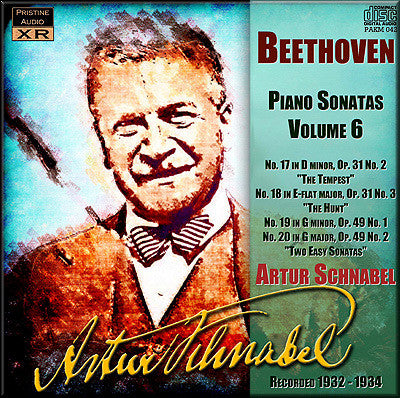
This album is included in the following sets:
This set contains the following albums:
- Producer's Note
- Full Track Listing
- Cover Art
The legendary Schnabel Beethoven series continues
"The sound quality ... made me rethink my conception of Schnabel"
- Classical CD Review
As with previous volumes in this series, the sides here show some variability of surface noise and coarseness, the latter being most obvious in the first movement of the 20th Sonata, but also evident in louder sections of the first movement of Sonata No. 17. Perhaps this isn't always a bad thing - a reminder that these recordings were made nearly 80 years ago is useful when the sonic transformations achieved with XR remastering and Capstan pitch stabilisation are so astonishingly great!
Andrew Rose
-
BEETHOVEN Piano Sonata No. 17 in D minor, Op. 31 No. 2 "The Tempest"
Recorded 27 April 1934, issued as HMV DB 2649-51
Matrix Numbers 2B.6178-82. Takes 2, 2, 2, 2, 4
-
BEETHOVEN Piano Sonata No. 18 in E-flat major, Op. 31 No. 3 "The Hunt"
Recorded 25 March 1932, issued as HMV DB 2358-60
Matrix Numbers 2B.3254-58. Takes 1, 2, 1, 2, 2
-
BEETHOVEN Piano Sonata No. 19 in G minor, Op. 49 No. 1
Recorded 19 November 1932, issued as HMV DB 1956
Matrix Numbers 2B.4530-31. Takes 1, 4
-
BEETHOVEN Piano Sonata No. 20 in G major, Op. 49 No. 2
Recorded 12 April 1933, issued as HMV DB 2214
Matrix Numbers 2B.6622-23. Takes 1, 1
Artur Schnabel piano
Gramophone Historic Review
"Not the least good thing about the eighth volume of the Beethoven Sonata Society is Eric Blom's most entertaining essay " Lurid Light on Beethoven.' which consists of an examination of a new book by an eminent German musical scholar, Dr. Arnold Schering.
In this work only the first volume of which has been issued—the author discovers that five string quartets and eight piano sonatas of Beethoven are based on plays by Shakespeare and another sonata on Schiller's "Maid of Orleans " ! And the two sonatas, amongst the eight, attached by the worthy doctor to the " Tempest" and to "Much Ado About Nothing" are those in D minor (Op. 31, No. 2) and F major (Op. 54) included in this album...
Schnabel rises to the full measure of the great Sonata in D minor, the first movement of which is full of superb rhythmic energy. But why on earth does he keep the sustaining pedal down throughout the two lovely recitatives in the middle of the movement? ' The poet speaks" : but why this jangling utterance? I should be most interested to hear an explanation of this interpretative eccentricity.
The adagio, as so often with this player, lacks tenderness and is too heavy : and personally I like the final movement to be less explosive than this. The phrasing and the rhythmic impulse in this wonderful movement are splendid, but I missed the effect of the lovely dissolving harmonics just before the last page and I am inclined to agree with the much-belaboured Schering that the figuration of this movement should be, for the most part, "gently soaring."
The recording of all the sonatas is good if
a little coarse, and as I have intimated, there is plenty of matter for
discussion in Schnabel's interpretations, besides lots for any pianist
to learn and profit from."
From The Gramophone, April 1936, by A.R.

